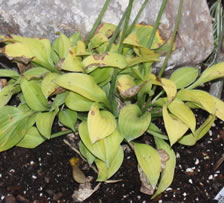
Hostas and Drought - How Much Water Do They Need?
By Josh Spece
August 16, 2012
 The summer of 2012 has been hot and dry across much of the United States. Record after record has been shattered and entire fields of crops are dead. What do extended periods of dryness mean for hostas?
The summer of 2012 has been hot and dry across much of the United States. Record after record has been shattered and entire fields of crops are dead. What do extended periods of dryness mean for hostas?
In their native land, hostas typically receive around 60 inches of rainfall in a year. Compared to Iowa's annual average rainfall of between 35 and 40 inches, even in a normal year hostas don't receive as much rain as they are accustomed to. We know how adaptable they are, though, and they usually manage just fine.
From mid May through August 8, 2012, the entire state of Iowa was between 4 and 8 inches of rain below normal. The effects of the lack of moisture are painfully obvious in our gardens. Many hostas have burned leaf edges and some have completely dried up.
Are My Hostas Dead?
I have received a number of emails and phone calls from heart broken gardeners wanting to know if their dried up hostas are dead. The answer is no, probably not, unless the plant was very tiny and struggling to begin with. A healthy hosta can go dormant in order to survive periods of extreme dryness. If your hostas have lost all their leaves, they have likely gone dormant.
Long Term Affects of Drought on Hostas
Brown leaves and dormant plants are the short term result of the dry summer. To understand how drought will affect our hostas in the long term, we need to know a little about the growth cycle of a hosta. When a hosta emerges in the spring, it is emerging on the energy and food reserves that the plant stored in its rhizome late the previous summer and fall. If the hosta received sufficient water in late summer and fall, it should emerge the next spring as a larger plant because it was able to store away more energy than it used. However, a hosta that does not receive adequate moisture in late summer and fall can not build up the energy reserves it needs to increase in size. The result is a hosta that emerges the following spring smaller than it was the year before.
A dry summer and fall is often the cause of a hosta that shrinks in size from one year to the next. Multiple unusually dry summers in a row can be especially devastating for hostas, as they are unable to replenish their depleted energy reserves.
How Much Water Do Hostas Need?
So, what can you do? Water, water, water!
If you have hostas that have gone dormant as a result of the drought, watering them will likely encourage a flush of new leaves to grow. If you begin watering, though, it is best to keep watering regularly until frost. Encouraging new growth, only to let the plant die back again from lack of water is a waste of what little reserves the plant has.
In an ideal hosta garden, the plants would receive generous watering all season long. A slow, deep soaking of around an inch of water per week through the growing season is perfect. A single deep soak every week is always better than multiple, light waterings. Deep watering encourages the roots to grow deeper into the ground where they can still find moisture during short periods of dryness. Frequent, light watering encourages the hosta roots to grow near the surface of the soil where they can quickly dry out even in short dry spells.
Hostas can tolerate periods of dryness, if they are otherwise healthy. However, hostas that are never stressed from lack of water will grow bigger, faster and will hold up and look nice longer into the season. Usually, they can fend for themselves, but watering during periods of dryness will certainly help our hostas look and grow their best.
All content and images © 2024 by In The Country Garden & Gifts unless otherwise noted.
